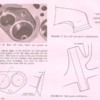Closing down the intake ports on the Boss 302 head with epoxy was done by the Shelby Racing team in 1969.
The head work was done by the Valley Head Service.
I have the article around somewhere but at the moment can't find it.
I am told now by a very knowledgeable source that was there at ground zero then, it was considered an experiment.
The car was run in one or two races with the closed down ports and was then returned to the large port configuration.
I have a pair of the Ford Motorsport A3 heads. They are not out of the box stock and came off a race prepared "circle track" race car.
The owner was switching over to the C302B heads for greater throttle response.
The ports are untouched, there is pocket work that resembles the suggested pocket work in the scan that I posted, and the heads were shaved.
For me, these things are what you want in a race Cleveland. I have seen many sets of "professionally ported" C302 heads(translate that into big bucks spent on the "bench") and I find it ironic that in many cases the finished port comes out looking very, very much like the stock A3 port does?
The Shelby Race heads from way back, ironically resemble these things too.
I do recall Don Nicholson, aka Dyno Don, being asked about these aluminum heads (the series of them, i.e., the A3, B351, C302, etc) and from memory his comment was "I was making substantially more horse power with the iron 4v heads than I can we these aluminum heads". That is a paraphrasing from memory.
I can't go back and ask Don since he passed away about 12 years ago or so? The point is, the 4v iron heads are not junk and you CAN make significant power with them.
I do believe that he is credited with the modification to the exhaust port of cutting out the entire section of the head and bolting in an "extension" that is made out of aluminum bar stock.
If you look at them, they go up like the aluminum Motorsport heads do. I think that George has a nice picture of a set of them in his 351c documentation section on his Facebook page.
The reason that I mention this at all is that I do believe that at least the first Gp4 factory car used that set up on the engine.
Unfortunately those engines were the first of the 351c engines road raced and needed race development. As a result there were a lot of engine failures early on and the Pantera developed an early reputation in the European race circles as being undependable under race conditions.
If you are going to be serious about racing this engine then the selection of the head you are going to use should be considered for the location of a better exhaust port than cast stock. Ultimately in that head, that is the restricting component.
As far as what size primary tubes and collector lengths to use on the headers, as well as primary tube lengths, I think that you are going to find a smaller tube works better on a shorter track and a larger tube on the longer. The lengths of the primaries with 180s might just be academic discussion simply because it is so difficult to get equal lengths on a set like this. Probably the average length you are going to be able to get is about 34". That's about what the average length is of mine and in looking at them, it's difficult to see where they could be made more equally. It actually shouldn't be the length of the tube you are trying to equalize necessarily, it is the volume in the tube. Try "cc'ing" headers. If it isn't a nightmare, it's probably the closest thing you could get to one?
I suppose this all depends on how much you can invest in the headers? You could get Halls, like I have for $850 or you could have someone build you a set for $3500? That's your call and is why race teams with seemingly unlimited budgets tend to be more consistently competitive? The expression with financing race cars is that you need "cubic dollars".





